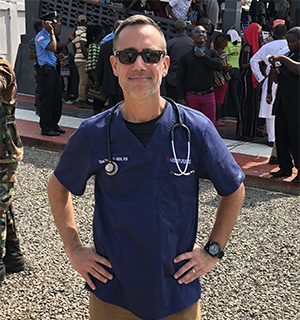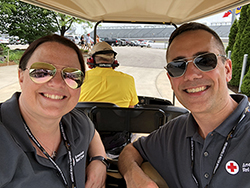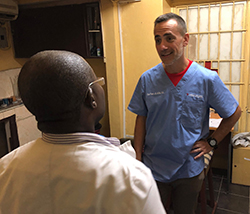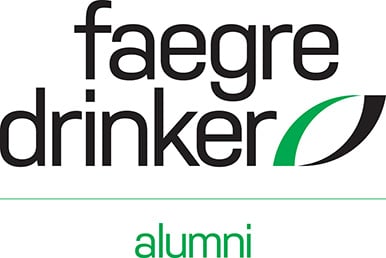Alumni Q&A: Chad Priest

Name: Chad Priest
Firm Background: Joined Faegre Baker Daniels predecessor Baker & Daniels in June 2005. He was a member of the firm’s Health Law & FDA group and a resident in the Indianapolis 96th Street location.
How does one go from working at a law firm to becoming the CEO at the Indiana Region of the American Red Cross? I imagine it is kind of a long story...
So, I left the firm in 2010 to become the inaugural chief executive officer (CEO) of the MESH Coalition, a public-private partnership that supports health care organization preparedness for disaster and crisis events. The firm, under the leadership of Scott Chinn, served as counsel to the coalition’s predecessor and was a catalyst in the development of the concept, which became the national model for health care preparedness. While at MESH, I joined the faculty of the IU School of Medicine, Department of Emergency Medicine, and helped create a postgraduate fellowship program in disaster medicine. I continue to direct that program today. I also joined the IU School of Nursing as an adjunct assistant professor. Over the years, I became more involved in research and teaching. In 2014, I left MESH to assume the role of assistant dean for operations and community partnerships at the IU School of Nursing, while continuing my role at the IU School of Medicine. In addition to a myriad of special projects for the school, I continued to teach in Bloomington and continued my program of research focused on health care resilience to crisis events, including in West Africa. In 2015, a former firm client and friend, Dr. Lisa Harris of Eskenazi Health, reached out in her capacity as chair of the Board of the American Red Cross – Indiana Region, asking if I would consider applying to become the CEO. I joined the Red Cross shortly after and I'm humbled to continue to serve this humanitarian movement today.
How do you feel your time at the firm helped mold you as a leader?
I learned so much from my colleagues at Baker & Daniels. First, and most importantly, the leadership at B&D modeled for me what lawyering should look like. B&D lawyers are excellent lawyers, of course, but they are also community leaders. In Indiana, and around the world, B&D lawyers make things happen in their communities.
The firm also taught me how to write. I thought I knew how to write after law school, but partners from many different practice groups that I had the privilege to work with – especially my then-supervisor and friend, Mary Beth Claus – helped me become a better writer and communicator.

Finally, I've met some of the most influential people in my life through the firm. One of the first people I met was Courtney Roseberry [now Courtney VanJelgerhuis], at the time legal secretary to Fred Glass, Mary Beth Claus and Shaun Clifford. Courtney taught me so much about so many things, and 16 years later, she is still teaching me in her role as chief operating officer (COO) of the American Red Cross – Indiana Region.
I've tried very hard to model my career after some of my favorite partners at the firm – women and men of action and compassion.
What does that look like in practice in your current role?
As CEO of the American Red Cross – Indiana Region, I oversee our humanitarian operations in Indiana and in portions of Kentucky, Illinois and Ohio. My principal role is to support the over 4,000 employees and volunteers in our region, working from nearly 50 offices, who help build resilient communities in our region. It's an honor and privilege to work alongside these humanitarians and tell the story of their work. Ours is a complex global movement, and our operations in the Indiana region reflect the variety of services we provide. We're responsible for about half of the blood supply in this region; we respond to hundreds of disasters and home fires each year; we're the lifeline for military members and their families; we train thousands of persons in lifesaving skills; we connect families separated by war and disaster; and we teach the guiding principles of our movement, which are enshrined in the Geneva Conventions.
How has COVID-19 impacted operations?
Our preparation and planning for COVID-19 began in the winter when cases were first reported from Asia. Our entire national organization has been working nonstop for months to protect our blood supply and support basic needs in communities. This pandemic has been particularly challenging because our team is impacted just like everyone else. I have been so impressed by the creativity, agility and bravery of our team – they are making enormous sacrifices to support our communities.
With new developments flooding in every day, how does your team stay on top of community needs?

Situational awareness is a force multiplier for disaster organizations. Our team uses a variety of tools and a lot of sweat equity to turn data into information that informs our decision-making. We set incident management priorities to navigate COVID-19 early on and we update those priorities as often as needed to respond to community needs. As with any disaster, the most reliable and important source of information are communities – they already know what's happening and usually know how to help themselves.
Is any of your workforce currently remote? If so, how are you working to help people stay connected to one another?
Our biomedical and training services teams are continuing to work in the field. Most of our humanitarian services employees are working from home right now except when a disaster calls them out. Like many organizations, we're using a range of digital tools to stay connected. One of our new traditions is an all-staff happy hour on Friday afternoons. It gives us a chance to put eyes on every single employee to assess well-being and allow a space for the team to express appreciation to one another. The work we are engaged in can be stressful. Our team is wired for this work – it's in our DNA – but every single member of our team is also impacted by this pandemic. Being together, apart, has been critical to our work.
Are there any go-to resources on your radar, from a medical or scientific perspective?
The Regenstrief Institute at IU has put together a helpful dashboard that we use frequently. We are also developing a number of online programs and tools at the Red Cross to support individuals and families. You can go to https://www.redcross.org/local/indiana.html to learn more.


